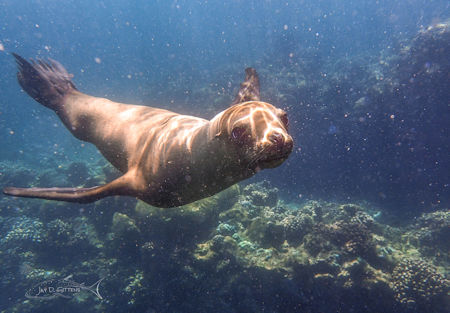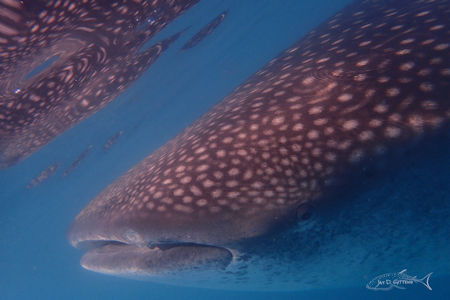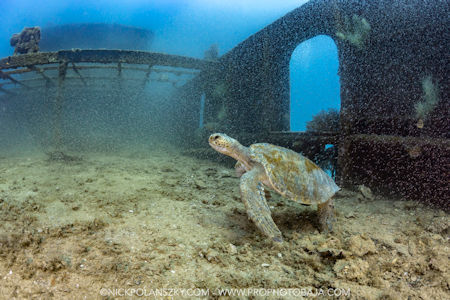 |  |

Diving and snorkelling in La Paz, Mexico.
Once dubbed “The World’s Aquarium” by none other than marine explorer and conservationist, Jacques-Yves Cousteau, the Gulf of California, also known as the Sea of Cortez, is located on the western side of Mexico, separated from the Pacific Ocean by the Baja California peninsula. Its surface area spans in excess of 60,000 square miles with depths surpassing 3,000 metres.
The Sea of Cortez creeped into existence some five million years ago when tectonic forces of an unimaginable scale slowly but surely separated the Baja peninsula from mainland Mexico resulting in the creation of a unique assemblage of marine and terrestrial organisms, some of which are endemic to the region.
The Gulf of California is still to this day widely considered to be one of world’s most biologically rich bodies of water, harbouring close to one thousand species of fish and a prize of majestic marine animals such as whales, dolphins, whale sharks, hammerhead sharks, bull sharks, sea turtles, oceanic giant manta rays, sea lions and even orcas.
La Paz Bay and its surrounding islands are home to a large number of the marine animals that can be found in the Sea of Cortez and it is this bounty of marine life that attracts ocean enthusiasts from across the globe to discover or revisit the great sites we have in this unique location.
Los Islotes – *suitable for diving and snorkelling
These rocky islets lay within the Espiritu Santo Archipelago forming one of three main no-take zones in the Espiritu Santo National Park. Los Islotes is home to some 400 plus California sea lions (Zalophus californianus) which are one of the most popular wildlife tourism attractions of the island group due to their abundance and the playful nature of the juveniles. Because fishing is prohibited here, the fish are present in all of the diversity and abundance that Jacques Cousteau once described. This site is suitable for both scuba divers and snorkelers, with the sea lions and most of the marine life occupying areas of shallow water close to the rocks, caves and crevices.

El Bajo – *suitable for diving only
El Bajo is comprised of three open-ocean seamounts located around 30 minutes north-east of Los Islotes. Amazing rock formations covered in marine life decorate the sea scape with a wide range of vivid colours and textures. The main attraction to El Bajo is the possibility of observing oceanic sharks; the most common species encountered being the scalloped hammerhead (Sphyrna lewini) and the silky shark (Carcharhinus falciformis). Even in the absence of these great beasts, El Bajo is a fantastic dive site crammed full with life.
La Reina – *suitable for diving and snorkelling
La Reina is a rocky islet situated off the northern-tip of Isla Cerralvo. It is home to a small bunch of California sea lions, mostly retired bulls banished from the main rookery of Los Islotes.
The dive site has some amazing rock formations, the most stunning of which is a submarine canyon whose walls are dressed in sea fans that quiver in the soft currents among colourful colonies of sponges.
The marine life here is in abundance. The main attraction of La Reina is the visitation of oceanic giant manta rays that grace the waters here from around mid-June to mid-October.
Swanne Reef – *suitable for diving and snorkelling
Located in the San Lorenzo Channel between La Paz and Espiritu Santo island, Swanne Reef, or Swanne Rock, lies under around 10 metres or 30 feet of water at its deepest point. The reef’s crown falls just short of the surface making it easily accessible to snorkelers. Due to the reef being located in the channel, it’s important to note that on occasion there can be moderate to strong currents resulting from tidal flows.
Swanne Reef is vibrant with life and colour and on occasion large schools of fish can be encountered here. If you are really lucky you may see sea lions and cormorants diving down to feast in amongst the schools.

El Salvatierra (shipwreck) - *suitable for diving only
The Salvatierra began its life during WWII in the Chesapeake Bay area serving as a ferry to carry shipyard workers across the bay. Sometime after the war ended, the ferry was bought at auction by the Ruffo family who brought the ship through the Panama Canal to La Paz to serve as a ferry to and from mainland Mexico.
In 1976 the Salvatierra ferry collided with Swanne Reef before drifting further across the channel and settling on her port side in 20 metres or 60 feet of water. A salvage operation was cut-short when Hurricane Liza passed over La Paz, resulting in a large number of deaths in the city and major destruction to its infrastructure. This violent storm also shifted the Salvatierra turning her upright but tearing the entire housing from the deck in the process rendering her unsalvageable.
Today the Salvatierra still remains and has attracted an abundance of marine life that is enjoyed by divers year-round. To me, it is one of the very best dive sites we have. As well as huge groupers and sea bass that can be seen tapering away into the sandy depths, this marine oasis attracts sea turtles, mobula rays and huge schools of fish and is carpeted with invertebrate life.
Fang Ming (shipwreck) - *suitable for diving only
The Fang Ming is a shipwreck originating from China. In 1995, she was seized by Mexican authorities for attempting to smuggle Chinese migrant workers into the United States and in 1999 she became Latin America’s first intentionally sunken ship for the purpose of creating an artificial reef.
Almost two decades down the line, the Fang Ming has developed into a haven for marine life harbouring numerous species of fishes, mobula rays and sea turtles to name but a few. This shipwreck is sheltered from much of the effects of winds and swells by Isla Espiritu Santo making it suitable for divers of all levels.
While much of the marine life in and around La Paz Bay is present year-round, some species are seasonal and in some cases are known to cover long distance migrations. The following information serves as an approximate guide to what marine wildlife attractions may be available throughout the year.
Whale sharks
Whale sharks are one of the long-distance migration species that somewhat predictably visit La Paz each year.
Each year around October, whale sharks begin to gather in the bay of La Paz. Historically November and December have the highest abundance but the species is present in sufficient numbers from around mid-October to the end of April.

While it is not possible to scuba dive with the whale sharks within the designated viewing area along the Mogote sand spit, visitors are able to snorkel with the sharks since the sharks spend much of their day on or close to the surface.
Sea lions
The California sea lions are permanent residents of La Paz and some of its islands. The two most popular locations to interact with sea lions are Los Islotes in the Espiritu Santo Archipelago and San Rafaelito, a small rocky islet in La Paz Bay itself. During the months of June, July and August for Los Islotes and June and July for San Rafaelito, it is not possible to snorkel or scuba dive with the sea lions as it is mating season for the species, however observation from a boat is permitted and can be very interesting to witness their courting behaviour and observe mothers’ nursing their new-born pups. For the rest of the year participants can enjoy in-water interactions with the species often leading to playful encounters with inquisitive juveniles that very often frolic in the shallow areas close to their shore.
Oceanic giant mantas
If you read my recent article about the giant mantas, you will know that they all but disappeared from La Paz for 15 years, returning in sufficient numbers just this year. The mantas historically occupied the area around La Reina between around mid-June and mid-November. This year the mantas arrived very close to past observations but they seemed to have left the area perhaps three weeks earlier than anticipated. Of course, the community waits in hope that the mantas return again next June.
Whales and dolphins
There exists no dedicated whale or dolphin watching tour service in La Paz itself because their presence is very random. La Paz has a year-round resident population of bottlenose dolphins and also a migratory population that visits during summer months. These dolphins can often be observed from the shore or a boat and occasionally will interact with swimmers in the water. From around December to April, various whale species such as gray, blue, humpback and fin whales can often be seen in the bay or around the islands just offshore.

Sea turtles
Of the seven species of sea turtle that roam today’s oceans, six of them are present in the Sea of Cortez. The two most commonly encountered species tend to be the green sea turtle (Chelonia mydas) and the olive ridley (Lepidochelys olivacea). At times, sea turtles can be somewhat wary of boats and swimmers but will on occasion allow and even initiate close encounters with humans, particularly when diving the shipwrecks.
The bounty of marine life around La Paz is remarkable both in terms of species richness and diversity. Properly managed ecotourism plays a great part in the awareness and education of our marine wildlife and in the oceans in general. Visitors and locals are urged to use reputable operators when diving or snorkelling here particularly as we have several threatened and/or protected species and areas. It is crucial that private boats do some research before embarking on trips within the National Park or around threatened species.
For more information about diving and snorkelling in La Paz you can visit the Facebook page of La Paz Dive Club, email lapazdivers(at)gmail.com or call +52 1 (612) 197 5824.
Contact:
+52 1 (612) 197 5824
Website
bajawildlifediaries(at)gmail.com

Super-easy and instant. Very happy with initial purchase.

They told me not to worry after my incident in Mexico, of course I did. Silly me, they talked me...